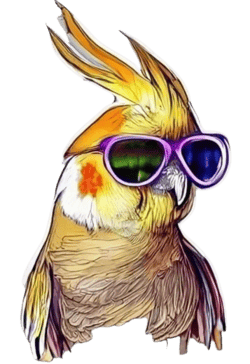The Ultimate Guide to Understanding when do Cockatiels Molt
Bird pets are true companions, and cockatiels are no exception. They are entertaining, sociable, and can fill your house with joyful chirps. But as with all pets, owning a cockatiel means understanding and becoming attuned to their unique behaviors and biological processes, one of which is molting. This guide will explain all you need to know about this interesting process.
Introduction: The Molting Process in Birds
Molting, in simplest terms, is the process of shedding and regenerating feathers. Similar to how we humans shed and regrow our hair, birds also go through a similar cycle with their plumage, which is what we know as molting.
The molting process may seem alarming at first, especially for a new bird owner, but it’s an entirely natural aspect of a bird’s life. It allows them to replace damaged feathers and maintain their ability to fly effectively.
Feathers are not only crucial for flight but also play a significant role in the bird’s insulation, camouflage, and attraction of potential mates. Therefore molting, while sometimes appearing a bit distressing or inconvenient, is an essential part of a bird’s life – and this includes our adorable and feathered friend, the cockatiel.
When Do Cockatiels Molt: Knowing the Timing
A common question is when do cockatiels start to molt? Typically, cockatiels will begin their first molt when they are around 6 to 12 months old. However, this may vary depending on the individual bird’s condition and other factors.
The timing of molting in cockatiels can also be influenced by seasonal changes, with many birds often beginning to molt as daylight hours increase or decrease. However, domestic cockatiels that live indoors may not adhere strictly to these seasonal timings.
On average, a cockatiel may molt a few times a year, usually occurring in cycles that spread out every few months.
Recognizing Signs that a Cockatiel is Molting

Knowing how to recognize the signs of a cockatiel’s molting process can help alleviate any unnecessary worry about your bird’s health. Physical signs of cockatiel molting include finding feathers around their cage or noticing patches of new, downy feathers on your bird.
When molting, cockatiels may also behave differently. You might notice the bird preening more often or appearing slightly irritable. These behavioral changes are typically a good indication of a molting period.
However, it’s essential to understand the difference between normal molting and potential health problems. If your cockatiel appears noticeably distressed, is losing an unusual number of feathers, or not growing new ones, it would be wise to consult with a vet.
How to Care for a Molting Cockatiel
During the molting period, extra care and attention can help your feathered friend feel more comfortable. Nutritionally, your cockatiel will need more protein to grow new feathers, so incorporating more eggs, lean meat, or legumes into the bird’s diet can be beneficial.
Grooming-wise, helping your cockatiel with a gentle mist bath or brushing can aid in the new feather growth. However, be sure to be extra gentle as new feathers can be quite sensitive.
Providing a quiet and stress-free environment is also necessary during the molting period. Reducing loud noises, handling the bird gently, and ensuring they have plenty of rest can all contribute to a more comfortable molting process.
If you’re wondering about grooming tips, check out our guide on “How to Cut Cockatiel Nails.” It provides step-by-step instructions and insights into the proper way to trim your cockatiel’s nails, ensuring a safe and comfortable experience for both you and your bird. Remember, grooming is an essential aspect of cockatiel care, and doing it right contributes to their overall well-being. If you have any concerns or need specific advice, consulting with a vet is always a good idea.
Addressing Common Issues during Cockatiel Molting
On occasion, molting can give rise to a few issues. Feather plucking, for instance, can become a problem if the bird is overly distressed or uncomfortable. If you notice this behavior, seek advice from a vet to identify any potential issues causing this behavior.
Health problems related to molting, such as feather mites or poor feather condition, may also arise. Therefore, regular check-ups with a vet.

About Me
I’m Kamran, a co-founder and content creator at cockatielhq.com. With 8+ years in the world of avian enthusiasts, I’ve gained extensive knowledge in caring for birds. From egg-laying and mating to cohabitation with other birds, dietary needs, nurturing, and breeding, I’m here at cockatielhq.com to share valuable insights for your avian companions.








3 Comments